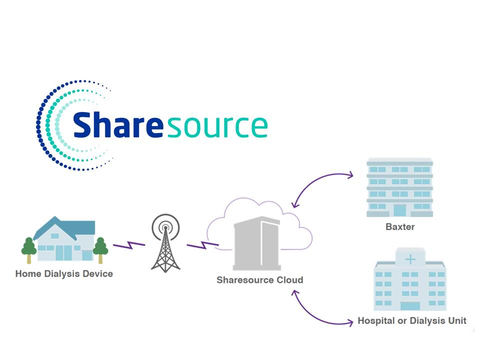Baxter Presents Data Indicating Sharesource Increases Patients’ Time on Home Dialysis by More Than Three Months
Baxter International (NYSE:BAX) has released new data indicating that its Sharesource remote patient management platform may enhance clinical effectiveness for home dialysis patients. A study presented at the World Congress of Nephrology showed that patients using Sharesource experienced an average increase of 3.4 months in time on therapy compared to those without the platform. This research involved nearly 1,500 patients in Colombia over a two-year period, supporting the growing evidence that digital health solutions are beneficial in kidney care.
- Sharesource may improve time on therapy by 3.4 months for home dialysis patients.
- Study supports growing evidence of Sharesource's effectiveness in enhancing home dialysis care.
- None.
- Increased time on therapy is an important indicator that remote patient management can improve clinical effectiveness and quality of care for kidney patients on home dialysis
- The new data is part of a growing body of evidence that Sharesource can support enhanced home dialysis care

New data indicate the use of Baxter’s Sharesource remote patient management platform with an automated peritoneal dialysis cycler may improve the clinical effectiveness of home kidney patients care by extending their time on therapy. (Graphic: Business Wire)
The new data was presented during the
“Time on therapy is one of the most important indicators of clinical effectiveness and quality improvement for home kidney patients using remote patient management,” said Peter Rutherford, MB BS, PhD., vice president, Medical Affairs, Baxter Renal Care. “Sharesource is a valuable tool in enabling healthcare professionals’ visibility and timely support of their home patients, which is a key factor in a growing body of clinical evidence that the digital health platform is supporting enhanced care.”
Sharesource, which allows healthcare professionals to monitor their patients’ home dialysis treatments, and then remotely adjust therapy without the need for patients to make unplanned visits to the clinic, has also been shown to reduce hospitalizations and costs, travel to clinical facilities and wait times. 2,3,4,5,6
The time on therapy study presented at the
Sharesource is available on Baxter’s Homechoice Claria and Amia APD systems in
About Peritoneal Dialysis
People living with end-stage renal disease require dialysis treatment or a kidney transplant to stay alive. PD therapy is typically managed by patients in their home, at a time of day that is convenient for them. It works by cleaning the blood of toxins and removing extra fluid through the body’s peritoneal cavity. Studies show patients and physicians often prefer home dialysis.7 PD patients experience improved early survival, and higher satisfaction rates and quality-of-life measures.8,9,10
About Baxter
Every day, millions of patients, caregivers and healthcare providers rely on Baxter’s leading portfolio of diagnostic, critical care, kidney care, nutrition, hospital and surgical products used across patient homes, hospitals, physician offices and other sites of care. For 90 years, we’ve been operating at the critical intersection where innovations that save and sustain lives meet the healthcare providers who make it happen. With products, digital health solutions and therapies available in more than 100 countries, Baxter’s employees worldwide are now building upon the company’s rich heritage of medical breakthroughs to advance the next generation of transformative healthcare innovations. To learn more, visit www.baxter.com and follow us on Twitter, LinkedIn and Facebook.
This release includes forward-looking statements concerning potential benefits associated with Sharesource, Amia, Homechoice Claria or Kaguya. The statements are based on assumptions about many important factors, including the following, which could cause actual results to differ materially from those in the forward-looking statements: demand for and market acceptance for new and existing products; product development risks; inability to create additional production capacity in a timely manner or the occurrence of other manufacturing or supply difficulties (including as a result of natural disasters, public health crises and epidemics/pandemics, regulatory actions or otherwise); satisfaction of regulatory and other requirements; actions of regulatory bodies and other governmental authorities; product quality, manufacturing or supply, or patient safety issues; changes in law and regulations; and other risks identified in Baxter's most recent filing on Form 10-K and Form 10-Q and other
Baxter, Sharesource, Amia, Homechoice Claria and Kaguya are registered trademarks of
1 Sanabria M, et al. Time on Therapy in Automated Peritoneal Dialysis Patients with and without Remote Patient Monitoring Program: A Propensity Score Matching Cohort Study. Abstract presented at |
2 Darkins, A, et al. Care Coordination/Home Telehealth: The systematic implementation of health informatics, home telehealth, and disease management to support the care of veteran patients with chronic conditions. Telemed. |
3 Broderick, A, and Lindeman, D. Scaling Telehealth Programs: Lessons from Early Adopters. |
4 Clarke, M, Shah, A, |
5 Inglis, SC, Clark, RA, McAlister, FA, Stewart, S, Cleland, JGF. Which components of heart failure programmes are effective? A systematic review and meta-analysis of the outcomes of structured telephone support or telemonitoring as the primary component of chronic heart failure management in 8323 patients: Abridged Coc. Eur. J. Heart Fail. 13, 1028–40 (2011). |
6 Klersy, C, De Silvestri, A, Gabutti, G, Regoli, F, Auricchio, A. A meta-analysis of remote monitoring of heart failure patients. J. Am. Coll. Cardiol. 54, 1683–94 (2009). |
7 Rivara MB, Mehrotra R. The Changing Landscape of Home Dialysis in |
8 Rubin HR et al. Patient ratings of dialysis care with peritoneal dialysis vs hemodialysis. JAMA. 2004 Feb 11;291(6):697-703. |
9 Juergensen, et al. Hemodialysis and peritoneal dialysis: patients’ assessment of their satisfaction with therapy and the impact of the therapy on their lives. Clin J Am Soc Nephrol. 2006; 1(6): 1191-1196. |
10 Zazzeroni L HR et al. Comparison of quality of life in patients undergoing hemodialysis and peritoneal dialysis: a systematic review and meta-analysis. Kidney Blood Press Res. 2017;42(4):717-727. USRDS ADR 2018: Vol 2 ESRD, Chap 5; Fig 5.1. |
View source version on businesswire.com: https://www.businesswire.com/news/home/20220301005354/en/
Media Contact
media@baxter.com
Investor Contact
Source:
FAQ
What are the benefits of Baxter's Sharesource platform for dialysis patients?
When was the study on Sharesource presented?
How many patients were involved in the Sharesource study?
Which company developed the Sharesource platform?







